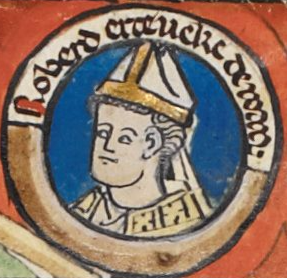
Robert "Guiscard" de Hauteville, sometimes Robert "the Guiscard", was a Norman adventurer remembered for his conquest of southern Italy and Sicily in the 11th century.

Roger I, nicknamed “Roger Bosso” and “Grand Count Roger”, was a Norman nobleman who became the first Grand Count of Sicily from 1071 to 1101.
Tancred of Hauteville was an 11th-century Norman petty lord about whom little is known. He was a minor noble near Coutances in the Cotentin. Tancred is primarily known by the achievements of his twelve sons.

Alan III of Rennes was Count of Rennes and duke of Brittany, by right of succession from 1008 to his death.

Humphrey of Hauteville, surnamed Abagelard, was the count of Apulia and Calabria from 1051 to his death.

Robert II, Archbishop of Rouen, and Count of Évreux was a powerful and influential prelate, and a family member of and supporter of five dukes of Normandy.
Serlo I of Hauteville was a son of Tancred of Hauteville by his first wife, Muriella, probably the youngest, though some sources call him the eldest. Born before 1010, he was the eldest son of Tancred's to remain in Normandy. After a dispute with a neighbour, whom he killed over an insult, Serlo was exiled for three years. Around 1041, his father died and he inherited the small fief of Hauteville in the Cotentin and the sirery of Pirou through his wife. He was regarded, as were his brothers, as an exceptional warrior.
GaufredoMalaterra was an eleventh-century Benedictine monk and historian, possibly of Norman origin. He travelled to the southern Italian peninsula, passing some time in Apulia before entering the monastery of Sant'Agata at Catania, on the isle of Sicily. Malaterra indicates that, prior to his arrival in Catania, he had spent an undefined period away from monastic life, in the worldly service of "Martha".
Geoffrey of Hauteville was a Norman military leader, the second youngest son of Tancred of Hauteville by his first wife Muriella. He joined his brothers in the Mezzogiorno around 1053, arriving with his half-brothers Mauger and William. He was certainly present at the Battle of Civitate in that year.
Mauger of Hauteville was a younger son of Tancred of Hauteville by his second wife, Fressenda. He travelled to the Mezzogiorno with his brother William and his elder half-brother Geoffrey around 1053, though some sources indicate him coming later, c.1056.
William of Hauteville was one of the younger sons of Tancred of Hauteville by his second wife Fressenda. He is usually called Willermus instead of Wilelmus in Latin annals and so is often called Guillerm instead of Guillaume in French.
Geoffrey the Elder was an Italo-Norman nobleman. A nephew of Robert Guiscard through one of his sisters, he was the count of Conversano from 1072 and the lord of Brindisi and Nardò from 1070, until his death.

The House of Hauteville was a Norman family originally of seigneurial rank from the Cotentin. The Hautevilles rose to prominence through their part in the Norman conquest of southern Italy. By 1130, one of their members, Roger II, was made the first King of Sicily. His male-line descendants ruled Sicily until 1194. Some Italian Hautevilles took part in the First Crusade and the founding of the Principality of Antioch (1098).
Robert de Grantmesnil also known as Robert II, was a Norman nobleman; a member of a prominent Norman family. He first became a monk, then abbot at the Abbey of Saint-Evroul in Normandy and later Bishop of Troina in the Norman Kingdom of Sicily.
Rodulf of Ivry was a Norman noble, and regent of Normandy during the minority of Richard II.
Sprota was an early 10th century woman of obscure origin who became wife 'in the Viking fashion' of William I, Duke of Normandy, by her becoming mother of his successor, Duke Richard I. After the death of William, she married a wealthy landowner, Esperleng, by him having another son, Norman nobleman Rodulf of Ivry.
Ralph of Gacé, also known as Ralph the Ass-Headed, was a member of the House of Normandy who played an influential role during the minority of William the Bastard, prior to his conquest of England. Ralph was the lord of Gacé and other estates in Normandy.

Judith d'Évreux was a Norman noblewoman and Countess of Sicily.
Giroie, Lord of Echauffour and Montreuil-l'Argillé, was a knight from Brittany who became a Norman nobleman and the progenitor of a large family in Normandy, England, and Apulia.
Events during the year 1103 in Italy.






